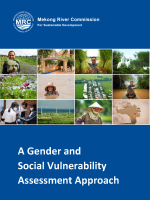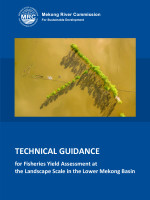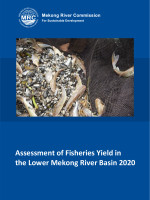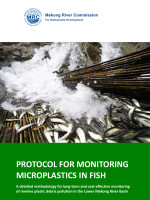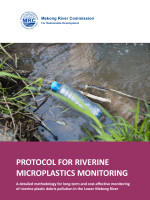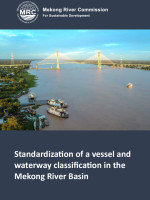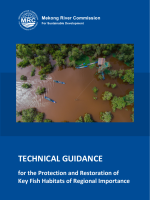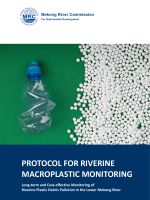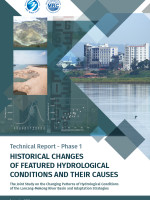Publications in English
A Gender and Social Vulnerability Assessment Approach
The report on an approach for gender and social vulnerability assessment is a supporting tool – or a guiding note – to assist the MRC to conduct the gender and vulnerability assessment in the Lower Mekong Basin. While the approach focuses on floods, droughts, and extreme storm events for the MRC’s future application, the overall gender and vulnerability framework described in this report could be applied to water resource development in the Mekong. It describes the steps for calculating exposure, sensitivity, and adaptive capacity components to determine an overall vulnerability score at the province level for each of the Mekong countries, which will shed light on possible strategies and measures to reduce vulnerability and achieve greater gender equality.
Download | DOI: 10.52107/mrc.bjk3zl | Published on: 08 Mar 2024 | Language: English
Development and update of water level and discharge rating curves for the Mekong mainstream
This technical note is an update of analysis of the rating curves for mainstream and tributaries of the Mekong River for 2009-2012, published in 2013, discussing the approach and methodology of rating curve establishment. The current publication underscores the Mekong River Commission Secretariat’s (MRCS) commitment to advancing integrated data management. The MRCS adopts the Time Series Management Software, AQUARIUS, to migrate rating curve development. This shift aims to establish a centralised, easily maintainable system, ensuring a reliable source of accurate water data. The transition of rating curve development to AQUARIUS is anticipated to enhance the efficiency, accuracy, and defensibility of water data management processes.
Download | DOI: 10.52107/mrc.bjv4xx | Published on: 20 Feb 2024 | Language: English
Technical guidance for fisheries yield assessment at the landscape scale in the Lower Mekong River Basin
The Technical Guidance aims to establish a systematic framework for generating, acquiring, and analyzing data using GIS in order to estimate the yield of fish and other aquatic animals (OAAs) from the Lower Mekong Basin. This approach, which is based on catch data from fishers, provides a novel method to determine the yield per unit of habitat area and extrapolate catch data from the Basin. By doing so, it offers increased certainty to all stakeholders involved in joint fisheries initiatives, particularly in transboundary areas, by clarifying roles and responsibilities. In addition, the document outlines quality control procedures for ensuring the reliability of the data, including fish catch verification, data validation, and method calibration.
Download | DOI: 10.52107/mrc.bgu8bl | Published on: 06 Feb 2024 | Language: English
Assessment of fisheries yield in the Lower Mekong River Basin 2020
MRC conducts periodic assessments of fisheries yield in different regions of the Lower Mekong Basin ):MB) to inform policy decisions and understand trends in catches and the value of aquatic living resources over time. The assessments conducted in 2020 suggest that the annual finfish yield from the LMB falls within the range of 1.51 to 1.71 million tonnes, while the harvest of other aquatic animals (OAA) is approximately 443,000 tons. These findings reveal a considerable decline in catches, amounting to approximately 25-30%, compared to the assessments conducted in 2000 and 2010. The estimated value of the fish catch varies from USD 7.13 billion to USD 8.37 billion annually. In addition, the estimated value of the OAA harvest is approximately USD 1.13 billion.
Download | DOI: 10.52107/mrc.bivw7w | Published on: 05 Feb 2024 | Language: English
Protocol for Microplastic Monitoring in Fish
A detailed methodology for long-term and cost-effective monitoring of riverine plastic debris pollution in the Lower Mekong River Basin
With a recent study identified the Mekong River as one of ten rivers to contribute over 90% of plastic debris to the world’s marine environment, there is an urgent need for a reliable data and information on riverine plastic debris pollution and their impacts to the aquatic environment of Mekong River. This Protocol for Monitoring Microplastic in Fihs has been developed and finalized as one of three protocols of the MRC’s Detailed Methodology for the Long-term and Cost-effective Monitoring of Riverine Plastic Debris Pollution in the Lower Mekong River Basin (LMB). The finalization of the detailed methodology was made possible through the concerted efforts and commitment of the MRC Member Countries and support of experts at national, regional and global levels, and included rigorous processes of consultations, capacity building, and piloting to ensure that the methodology is adapted to the situation of the LMB. The methodology aims to provide the much-needed data and information for an improved knowledge and understanding on the pathway and behaviors of plastic debris pollution in the LMB, from land-based sources to riverine environment, and ultimately to the marine environment. Information derived from the long-term implementation of methodology can be used to assess the effectiveness of plastic waste management the LMB.
Download | DOI: 10.52107/mrc.bhv7va | Published on: 19 Jan 2024 | Language: English
Protocol for Riverine Microplastics Monitoring
A detailed methodology for long-term and cost-effective monitoring of riverine plastic debris pollution in the Lower Mekong River
With a recent study identified the Mekong River as one of ten rivers to contribute over 90% of plastic debris to the world’s marine environment, there is an urgent need for a reliable data and information on riverine plastic debris pollution and their impacts to the aquatic environment of Mekong River. This Protocol for Riverine Microplastic Monitoring has been developed and finalized as one of three protocols of the MRC’s Detailed Methodology for the Long-term and Cost-effective Monitoring of Riverine Plastic Debris Pollution in the Lower Mekong River Basin (LMB). The finalization of the detailed methodology was made possible through the concerted efforts and commitment of the MRC Member Countries and support of experts at national, regional and global levels, and included rigorous processes of consultations, capacity building, and piloting to ensure that the methodology is adapted to the situation of the LMB. The methodology aims to provide the much-needed data and information for an improved knowledge and understanding on the pathway and behaviors of plastic debris pollution in the LMB, from land-based sources to riverine environment, and ultimately to the marine environment. Information derived from the long-term implementation of methodology can be used to assess the effectiveness of plastic waste management the LMB.
Download | DOI: 10.52107/mrc.bh5hvu | Published on: 19 Jan 2024 | Language: English
Standardization of a vessel and waterway classification in the Mekong River Basin
The "Standardize vessel and waterway classifications" is to update and harmonize different standards, rules, and regulations to uniform common standards for the development and liberalization of waterway transport on the Mekong River System. It involves analyzing technical and operational criteria for vessel classification and proposing standardized either one waterway classifications for the whole Mekong River Basin or two classifications for the upper and lower parts. It develops a proposal for waterway classification for each stretch of the Mekong River, its tributaries, and canals. In addition, a comprehensive set of regulations for vessel and waterway classification in the Mekong River Basin is prepared for implementation in the four MRC Member Countries.
Download | DOI: 10.52107/mrc.bgo9gq | Published on: 29 Dec 2023 | Language: English
Technical Guidance for the Protection and Restoration of Key Fish Habitats of Regional Importance
The fisheries resources of the Lower Mekong Basin are under considerable pressure from rapid economic development. Consequently, Technical guidance for the protection, restoration and improvement of key fish habitats of regional importance has been developed. The Technical Guidance is process-driven and identifies different levels of information, data collection and actions required to improve the conservation and sustainability of fish species, populations, communities, as well as other aquatic animals, in the LMB. The Technical Guidance adopts the Drivers–Pressures –State –Impact–Response (DPSIR) approach to identify the main threats to fisheries, and design, implement and monitor the most appropriate actions.
Download | DOI: 10.52107/mrc.bgs0ox | Published on: 28 Dec 2023 | Language: English
Protocol for Riverine Macroplastic Monitoring
Long-term and Cost-effective Monitoring of Riverine Plastic Debris Pollution in the Lower Mekong River
With a recent study identified the Mekong River as one of ten rivers to contribute over 90% of plastic debris to the world’s marine environment, there is an urgent need for a reliable data and information on riverine plastic debris pollution and their impacts to the aquatic environment of Mekong River. This Riverine Macroplastic Monitoring Protocol has been developed and finalized as one of three protocols of the MRC’s Detailed Methodology for the Long-term and Cost-effective Monitoring of Riverine Plastic Debris Pollution in the Lower Mekong River Basin (LMB). The finalization of the detailed methodology was made possible through the concerted efforts and commitment of the MRC Member Countries and support of experts at national, regional and global levels, and included rigorous processes of consultations, capacity building, and piloting to ensure that the methodology is adapted to the situation of the LMB. The methodology aims to provide the much-needed data and information for an improved knowledge and understanding on the pathway and behaviors of plastic debris pollution in the LMB, from land-based sources to riverine environment, and ultimately to the marine environment. Information derived from the long-term implementation of methodology can be used to assess the effectiveness of plastic waste management the LMB.
Download | DOI: 10.52107/mrc.bflvfj | Published on: 01 Dec 2023 | Language: English
Technical Report – Phase 1 of the Joint study on the Changing Patterns of Hydrological Conditions of the Lancang-Mekong River Basin and Adaptation Strategies
This is the 1st phase report of the Joint Study on the Changing Pattern of Hydrological Conditions of the Lancang-Mekong River Basin and Adaptation Strategies, conducted by the MRC and LMC Water Center. The report identifies two key factors that contribute to hydrological changes in the LMB. First are natural factors, including precipitation patterns, evaporation rates, soil properties and topography. Second are human activities, such as infrastructure development, water management, land cover and land-use changes. These two factors interact and influence the amount, timing and water distribution within the Basin.
Download | DOI: 10.52107/mrc.bd0zhw | Published on: 05 Oct 2023 | Language: English
